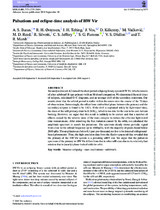Pulsations and eclipse-time analysis of HWVir
Date
2018Author
Baran, A. S.
Østensen, R. H.
Telting, J. H.
Vos, J.
Kilkenny, D.
Vuckovic, M.
Reed, M. D.
Silvotti, R.
Jeffery, C. S.
Parsons, S. G.
V. S. Dhillon, V. S.
Marsh, T. R.
Metadata
Show full item recordAbstract
We analysed recent K2 data of the short-period eclipsing binary systemHWVir,which consists
of a hot subdwarf-B type primary with an M-dwarf companion.We determined the mid-times
of eclipses, calculated O–C diagrams, and an average shift of the secondary minimum. Our
results show that the orbital period is stable within the errors over the course of the 70 days
of observations. Interestingly, the offset from mid-orbital phase between the primary and the
secondary eclipses is found to be 1.62 s. If the shift is explained solely by light-travel time,
the mass of the sdB primary must be 0.26M , which is too low for the star to be core-helium
burning. However, we argue that this result is unlikely to be correct and that a number of
effects caused by the relative sizes of the stars conspire to reduce the effective light-travel
time measurement. After removing the flux variation caused by the orbit, we calculated the
amplitude spectrum to search for pulsations. The spectrum clearly shows periodic signal
from close to the orbital frequency up to 4600 μHz, with the majority of peaks found below
2600 μHz. The amplitudes are below0.1 part-per-thousand, too lowto be detected with groundbased
photometry. Thus, the high-precision data from the Kepler spacecraft has revealed that
the primary of the HWVir system is a pulsating sdBV star. We argue that the pulsation
spectrum of the primary in HWVir differs from that in other sdB stars due to its relatively fast
rotation that is (nearly) phase-locked with the orbit.

